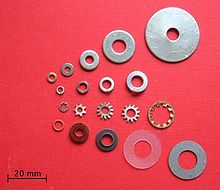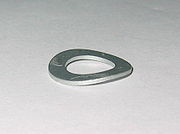- Washer (hardware)
-
A washer is a thin plate (typically disk-shaped) with a hole (typically in the middle) that is normally used to distribute the load of a threaded fastener, such as a screw or nut. Other uses are as a spacer, spring (belleville washer, wave washer), wear pad, preload indicating device, locking device, and to reduce vibration (rubber washer). Washers usually have an outer diameter (OD) about twice the length of their inner diameter (ID).
Washers are usually metal or plastic. High quality bolted joints require hardened steel washers to prevent the loss of pre-load due to Brinelling after the torque is applied.
Rubber or fiber gaskets used in taps (or faucets, or valves) to stop the flow of water are sometimes referred to colloquially as washers; but, while they may look similar, washers and gaskets are usually designed for different functions and made differently.
Washers are also important for preventing galvanic corrosion, particularly by insulating steel screws from aluminum surfaces.
The origin of the word is unknown; the first recorded use of the word was in 1346, however the first time its definition was recorded was in 1611.[1]
Contents
Types
Washers can be categorised into three types; plain washers, which spread a load, and prevent damage to the surface being fixed, or provide some sort of insulation such as electrical; spring washers, which have axial flexibility and are used to prevent fastening loosening due to vibrations; and locking washers which prevent fastening loosening by preventing unscrewing rotation of the fastening device; locking washers are usually also spring washers. The term washer is also often used for disc shaped devices used as grommets.
Plain washers
A plain washer (or 'flat washer') is a flat annulus or ring, often of metal, used to spread the load of a screwed fastening. Additionally a plain washer may be used when the hole is a larger diameter than the fixing nut.[2][3]
A spherical washer is part of a self-aligning nut; it is a washer with one radiused surface, which is designed to be used in conjunction with a mating nut in order to correct for up to several degrees of misalignment between parts.
An anchor plate or wall washer is a large plate or washer connected to a tie rod or bolt. Anchor plates are used on exterior walls of masonry buildings, for structural reinforcement. Being visible, many anchor plates are made in a style that is decorative.[4]
A flange nut is a nut with an integral fixed washer.
A torque washer is used in woodworking in combination with a carriage bolt; it has a square hole in the center where the carriage bolt square fits into. Teeth or prongs on the washer bite into the wood preventing the bolt from spinning freely when a nut is being tightened.[5]
Spring and locking washers
Belleville washers, also known as a cupped spring washer or conical washer, has a slight conical shape, which provides an axial force when deformed.
Curved disc spring is similar to a Belleville except the washer is curved in only one direction, therefore there are only four points of contact. Unlike Belleville washers, they only exert light pressures.[6]
Wave washers have a "wave" in the axial direction, which provides spring pressure when compressed. Wave washers, of comparable size, do not produce as much force as Belleville washers. In Germany, they are used as a lock washer, however they are ineffective.[7]
A split washer is a ring split at one point and bent into a helical shape. This causes the washer to exert a spring force between the fastener's head and the substrate. While this is supposed to act as a locking device, it is ineffective when it is tightened to become completely flat.[7][note 1] Applicable standards are ASME B18.21.1, DIN 127B, and United States Military Standard NASM 35338 (formerly MS 35338 and AN-935).[8]
A toothed lock washer, also known as a serrated washer or star washer,[7] has serrations that extend radially inward and/or outward to bite into the bearing surface. This type of washer is effective as a lock washer when used with a soft substrate, such as aluminum or plastic.[7] There are four types: internal, external, combination, and countersunk. The internal style have the serrations along the inner diameter of the washer, which makes them more aesthetically pleasing.[9] The external style have the serrations around the outer diameter, which provides better holding power, because of the greater surface area.[10] The combination style has serrations about both diameters, for maximum holding power.[11] The countersunk style is designed to be used with flat-head screws.[12]
Gaskets
The term washer is often applied to various gasket types such as those used to seal the control valve in taps. Crush washers are made of a soft metal such as aluminium or copper and are used to seal fluid or gas connections such as those found in an internal combustion engine.
A shoulder washer is a plain washer type with integral cylindrical sleeve; they are used to keep separate different metal types, and a seals.[13] This term is also used for electrically insulating grommets.[14]
Specialised types
A Keps nut or K-lock nut is a nut with an integral free spinning washer, assembly is easier because the washer is captive.
A top hat washer is a shoulder washer type used in plumbing for tap fitting.
Plain (left) and Split (right) washersBelleville or conical washerWave washerMaterials
Common materials include steel, stainless steel, and plastic. Hardened washers are steel washers that have been heat treated. Other materials include aluminum, aramids, bimetals, bronze, brass, ceramics, copper, felt, fibers, hastelloy, iron, leather, mica, Inconel, Monel, rubber, silicon bronze, zinc, and titanium.[15]
Standard metric flat washers sizes

Nominal screw
sizes M (mm)Screw pitch
thread P (mm)Internal (Inside) diameter
hole d1 (mm)External (Outside) diameter
d2 (mm)thickness
H (mm)1st
choice2nd
choicecoarse fine 1 0.25 1.1 3 0.3 1.2 0.25 1.3 3.5 0.3 1.4 0.3 1.5 4 0.3 1.6 0.35 1.7 4 0.3 1.7 1.8 4.5 0.3 1.8 0.35 2 0.4 2.2 5 0.3 2.5 0.45 2.7 6 0.5 2.6 2.8 7 0.5 3 0.5 3.2 7 0.5 3.5 0.6 3.7 8 0.5 4 0.7 4.3 9 0.8 5 0.8 5.3 10 1 6 1 0.75 6.4 12 1.6 7 1 7.4 14 1.6 8 1.25 1 8.4 16 1.6 10 1.5 1.25 or 1 10.5 20 2 12 1.75 1.5 or 1.25 13 24 2.5 14 2 1.5 15 28 2.5 16 2 1.5 17 30 3 18 2.5 2 or 1.5 19 34 3 20 2.5 2 or 1.5 21 37 3 22 2.5 2 or 1.5 23 39 3 24 3 2 25 44 4 27 3 2 28 50 4 30 3.5 2 31 56 4 33 3.5 2 34 60 5 36 4 3 37 66 5 39 4 3 40 72 6 42 4.5 3 43 78 7 45 4.5 3 46 85 7 48 5 3 50 92 8 52 5 4 54 98 8 56 5.5 4 58 105 9 60 5.5 4 62 110 9 64 6 4 66 115 9 68 70 120 10 72 74 125 10 76 78 135 10 80 82 140 12 85 87 145 12 90 93 160 12 100 104 175 14 See also
- Bit guard (horse tack), plain washer shaped device.
- Unified Thread Standard non-metric screw sizes
Notes
- ^ See the reference for an exhaustive explanation to why it does not work.
References
- ^ http://www.straightdope.com/columns/read/1713/whats-the-purpose-of-washers-the-round-metal-things
- ^ Paul Green (2007). The Mechanical Engineering Drawing Desk Reference: Creating and Understanding ISO Standard Technical Drawings. Lulu.com / CreateSpace. Washers, p.205. http://books.google.co.uk/books?id=b_AVSJwpMKMC&lpg=PR1&pg=PA205#v=onepage&q&f=false.
- ^ Nikolas Davies; Erkki Jokiniemi (2008). Dictionary of architecture and building construction. Architectural Press. Flat Washer, p.153. http://books.google.co.uk/books?id=1zbnm7IHxooC&lpg=PP1&pg=PA153#v=onepage&q&f=false.
- ^ Bucher, Ward (1996). Dictionary of Building Preservation. Preservation Press. pp. 576.
- ^ John Holloway (2010). Illustrated Theatre Production Guide. Focal Press. p. 202. http://books.google.co.uk/books?id=ZGJWz-ZuyJkC&lpg=PP1&pg=PA202#v=onepage&q&f=false.
- ^ McMaster-Carr catalog (115th ed.), McMaster-Carr, p. 1217, http://www.mcmaster.com/#catalog/116/1217/, retrieved 2010-11-26.
- ^ a b c d Smith, Carroll (1990), Carroll Smith's Nuts, Bolts, Fasteners, and Plumbing Handbook, MotorBooks/MBI Publishing Company, p. 116, ISBN 0879384069, http://books.google.com/books?id=A81HmmRCN7YC&pg=PA116.
- ^ McMaster-Carr catalog (115th ed.), McMaster-Carr, pp. 3217–3218, http://www.mcmaster.com/#catalog/116/3217/, retrieved 2010-11-25.
- ^ "Specifications for Internal Tooth Lock Washers ASME B18.21.1-1999". http://www.aspenfasteners.com/v/vspfiles/files/docs/internal_tooth_lockwasher_specification.pdf.
- ^ "Specifications for External Tooth Lock Washers ASME B18.21.1-1999". http://www.aspenfasteners.com/v/vspfiles/files/docs/external_tooth_lockwasher_specification.pdf.
- ^ "Specifications for Internal/External Tooth Lock Washers ASME B18.21.1-1999". http://www.aspenfasteners.com/v/vspfiles/files/docs/internal_external_tooth_lockwasher_specification.pdf.
- ^ "Specifications for Countersunk External Tooth Lock Washers ASME B18.21.1-1999". http://www.aspenfasteners.com/v/vspfiles/files/docs/countersunk_external_tooth_lockwasher_specification.pdf.
- ^ Brad Fox; Peter VanderWeyde (2008). Alloy boat corrosion: how to prevent it. Ripple Industries Pty Ltd. p. 16. http://books.google.co.uk/books?id=XD6ICxul6toC&lpg=PA16&dq=shoulder%20washer&pg=PA16#v=onepage&q&f=false.
- ^ "Fluorescent light". Popular Science (Bonnier Corporation) 186 (6): 117–118. June 1965. ISSN 0161-7370. http://books.google.co.uk/books?id=3SUDAAAAMBAJ&lpg=PA118&dq=shoulder%20washer&pg=PA118#v=onepage&q&f=false.
- ^ About Washer Materials, archived from the original on 2010-01-29, http://www.webcitation.org/5n9N9dsGV, retrieved 2010-01-29.
External links
- Typical USA Flat Washer Dimensions USS, SAE, Fender, and NAS washer ID & OD (mm)
- American National Standard (ANSI) Type B Plain Washers
- SAE Flat Washers Type A Plain Washers
- USS & SAE Combined Flat Washer Dimensions
- Flat Washer Thickness Table Steel Gage Thicknesses, non-metric
Categories:- Fasteners
Wikimedia Foundation. 2010.




